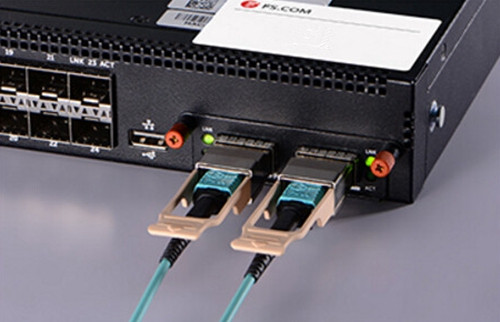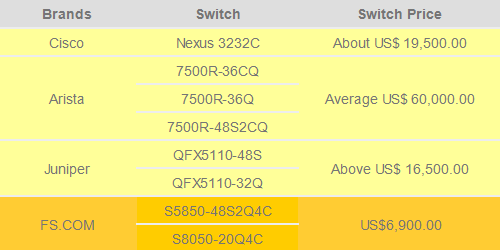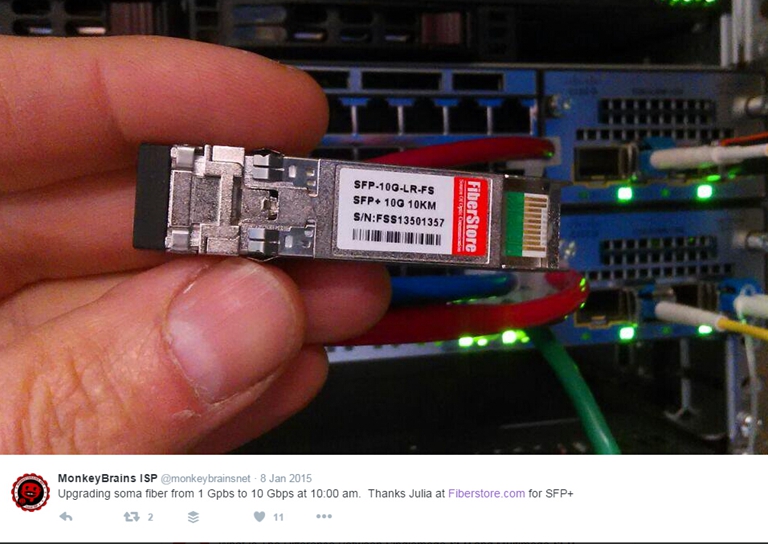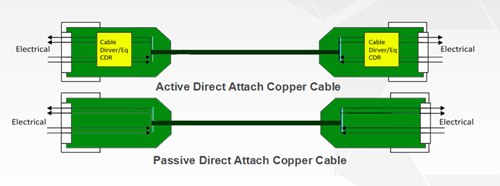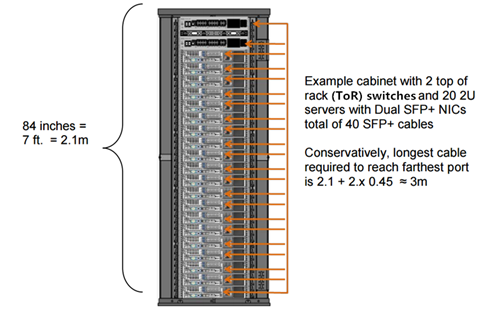Nowadays, most users choose to deploy 10G and 40G network that perform highly and efficiently in their systems. It cannot be denied that the bandwidth and capacity the 10G and 40G network provide are enough for their needs at present. However, due to the fast developing Ethernet network technology, the scale and traffic of Internet is rapidly expanding that will make the 10G and 40G network gradually obsolete and unsuitable for data centers, especially for the large-scale ones. Along with this trend, there is no doubt that the 100G network will become the mainstream in the near future. Are you now ready for the 100G network? Or still hesitating because of the high cost? In this paper, it will introduce some 100G QSFP28 AOC and switch solutions that can help you seek the most economical one to upgrade your system from 10G/40G to 100G.
100G QSFP28 AOC Solutions
QSFP28 AOC is a cost effective cable solution for 100G short distance transmission that consists of an OM4 multimode cable and two QSFP28 connectors, supporting 100G QSFP28 standards and compliant to the QSFP MSA (multi-source agreement). The length of the cable is usually available from 1 to 30 meters and its two QSFP28 connectors are fitted at each end of the OM4 multimode cable, very convenient for inserting into and removing from 100G QSFP28 ports. In data center, the QSFP28 AOC is really a low power alternative for 100G short distance transmission, which is highly recommended for the simplified intra rack and inter rack configurations. To seek the most economical QSFP28 AOC solution, the figure below shows the prices of several famous brands of QSFP28 AOC for your reference.
100G Switch Solutions
100G switch is an improved kind of network device designed for data center that offers the signal lane for any two 100G network nodes inserted into its ports. With the popularity of 100G network, it can be also available on many famous fiber optic manufactures like Cisco, Arista, Juniper, as well as the fiber optic manufacture FS.COM. With the aim of looking for a more economical 100G switch solution, the following will mainly introduce Cisco Nexus 3232C, Arista 7500R, Juniper QFX5110 and FS.COM S5850-48S2Q4C, both of which are fitted with QSFP28 ports to support QSFP28 AOCs.
The first type of switch–Cisco Nexus 3232C is a typical kind of low latency and high-performance 100G switch that can not only fulfill our current network needs but also suit for future applications such as big data, cloud and virtualization. And all its 100G QSFP28 ports can operate at 10, 25, 40, 50 and 100 GbE. The second type–Arista 7500R switch, including 7500R-36CQ, 7500R-36Q and 7500R-48S2CQ, is designed to lower power per 100GbE port and produce more reliable and dense network, which are available in a compact system design of 12, 8 and 4 slot. The third type–Juniper QFX5110 can be simply divided into QFX5110-48S and QFX5110-32Q, both of which have 100G QSFP28 ports to support QSFP28 AOC. All these three kinds of 100G switches are very expensive which can be learned from the following figure.
Compared to the previous three types, 100G switches like S5850-48S2Q4C and S5850-20Q4C provided by FS.COM can be available at a much lower cost. In details, the S5850-48S2Q4C has 48x10GbE SFP+ ports, 2x40GbE QSFP+ ports and 4x100GbE QSFP28 ports, while the S8050-20Q4C has 2x40GbE QSFP+ ports and 4x100GbE QSFP28 ports. Both of them are the cost effective switch solutions for building 100G network.
Discussion and Conclusion
From the text above, it can be easily learned that using Arista QSFP28 AOC and switch to deploy the 100G network would cost the most that can be as high as US$ 63,000.00, while the QSFP28 AOC and switch solution provided by FS.COM would be the most economical one, available at a quite low cost usually from US$ 7,440.00 to US$ 7,530.00. Considering that, you are recommendable to use the FS.COM QSFP28 AOC and switch solution for building your 100G network. If you have already had the switch like Cisco, Arista or Juniper, you are also suggested to choose FS.COM compatible QSFP28 AOC that has been tested to assure 100% compatibility, as a much more cost-effective cable solution.
